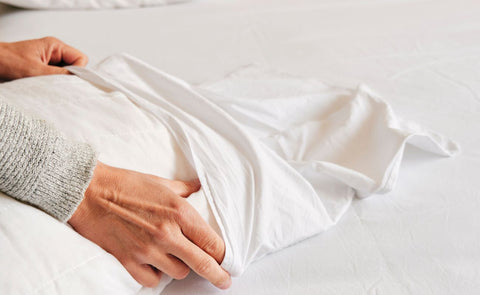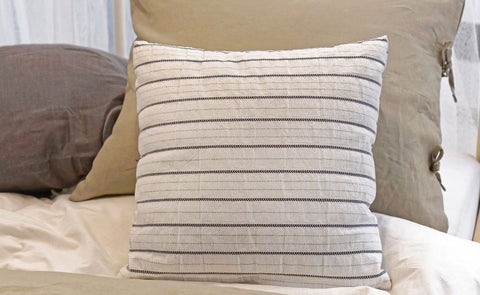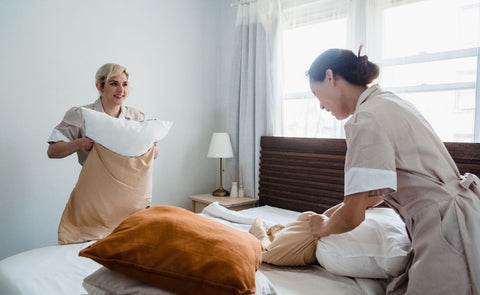Your Guide to Perfect Pillow Covers
When you're looking for the best type of pillow cover, you're making an important decision that affects your sleep quality every night. The right pillow cover not only protects your pillow but can also improve your sleep experience, reduce allergies, and even benefit your skin and hair. In this comprehensive guide, you'll discover the various types of pillow covers available, their unique benefits, and how to choose the perfect one for your specific needs.
Pillow covers are more than just decorative additions to your bedroom. They serve as the barrier between your face and your pillow, making the material choice crucial for comfort, health, and longevity of your bedding. Whether you're concerned about allergies, skin irritation, or simply want the most comfortable sleep experience possible, understanding what is the best type of pillow cover will help you make an informed decision.
Types of Pillow Covers: Material Matters
Silk Pillow Covers
Silk pillow covers are often considered a luxury option, and for good reason. These smooth, soft covers offer numerous benefits that make them worth considering despite their higher price point.
When you sleep on silk, your skin and hair glide across the surface with minimal friction. This reduced friction helps prevent sleep wrinkles and bedhead, making silk an excellent choice if you're concerned about anti-aging or maintaining your hairstyle overnight.
Silk is naturally hypoallergenic and resistant to dust mites, mold, and other common allergens. It's also temperature-regulating, helping you stay cool in summer and warm in winter. The natural protein fibers in silk contain amino acids that interact positively with your skin, potentially providing additional skincare benefits.
However, silk requires special care when washing and tends to be more expensive than other options. For many people, these drawbacks are outweighed by the luxury feel and beauty benefits.
Cotton Pillow Covers
Cotton remains one of the most popular choices for pillow covers, and with good reason. Available in various thread counts and weaves, cotton offers versatility for different preferences and budgets.
When you choose a cotton pillow cover, you're selecting a breathable, durable option that's easy to care for. Cotton wicks moisture away from your skin, helping you stay comfortable throughout the night. It's also naturally hypoallergenic and can be washed in hot water to eliminate allergens.
High thread count cotton (400+) offers exceptional softness while maintaining durability. Egyptian and Pima cotton varieties are particularly prized for their long fibers, which create an even smoother surface.
Cotton pillow covers are typically more affordable than silk alternatives and can withstand regular washing. However, they may not offer the same level of friction reduction for skin and hair.
Bamboo Pillow Covers
Bamboo fabric has gained popularity in recent years as an eco-friendly alternative with impressive performance characteristics.
When you select a bamboo pillow cover, you're choosing an option that's exceptionally soft—often compared to cashmere or high-thread-count cotton. Bamboo fabric is highly breathable and moisture-wicking, making it an excellent choice for hot sleepers or humid climates.
The natural properties of bamboo make it antimicrobial and hypoallergenic. It's also sustainable, as bamboo grows quickly without requiring pesticides or extensive water resources.
Bamboo pillow covers can be slightly more expensive than cotton but typically less costly than silk. They're also relatively easy to care for, though they may not have the same luxurious appearance as silk.
Microfiber Pillow Covers
Microfiber pillow covers are synthetic options typically made from polyester or nylon fibers.
When you opt for microfiber, you're selecting a budget-friendly choice that still offers considerable softness. These covers are lightweight, quick-drying, and generally wrinkle-resistant.
Microfiber pillow covers are easy to care for and come in a wide range of colors and patterns. However, they may not breathe as well as natural fibers, potentially trapping heat during the night. Some people also find that microfiber can create static or attract dust.
Linen Pillow Covers
Linen pillow covers offer a distinctive texture and excellent breathability that many sleepers appreciate.
When you choose linen for your pillow covers, you're selecting a material that gets softer with each wash while maintaining its durability. Linen is highly absorbent and moisture-wicking, making it ideal for warm climates or hot sleepers.
This natural material is made from flax fibers and has natural temperature-regulating properties. It's also resistant to bacteria and has a unique textured appearance that adds character to your bedding.
Linen does wrinkle easily and may feel slightly rough initially, though it softens considerably over time. It also tends to be more expensive than cotton options.
Tencel/Lyocell Pillow Covers
Tencel (also known as lyocell) is a sustainable fabric made from wood pulp, usually eucalyptus.
When you select Tencel pillow covers, you're choosing an option that combines some of the best qualities of natural and synthetic fibers. Tencel is incredibly soft, with a silky feel that rivals more expensive options.
These pillow covers offer excellent moisture management, absorbing humidity more efficiently than cotton. They're also naturally cooling and have antibacterial properties that help keep your pillow fresh.
Tencel is biodegradable and produced through an environmentally responsible process. While not as widely available as some other options, it's gaining popularity for its performance and sustainability credentials.
Special Types of Pillow Covers for Specific Needs
Waterproof Pillow Covers
Waterproof pillow covers provide protection against spills, sweat, and accidents—making them particularly useful for children's bedding or those with incontinence concerns.
When you choose a waterproof cover, you're investing in protection for your pillows against liquids, stains, and the growth of mold or mildew. Modern waterproof covers are typically made with a thin polyurethane or vinyl backing that prevents liquid penetration while maintaining comfort.
Quality waterproof covers are breathable and quiet (no crinkling sounds) despite their protective properties. They also provide an effective barrier against dust mites and allergens, making them excellent for allergy sufferers.
Hypoallergenic Pillow Covers
If you suffer from allergies or asthma, hypoallergenic pillow covers can significantly improve your sleep quality.
When you select a hypoallergenic cover, you're choosing a product specifically designed to block allergens like dust mites, pet dander, and pollen. These covers typically feature tightly woven fabrics with a pore size small enough to prevent allergens from penetrating.
Many hypoallergenic covers are also treated with antimicrobial finishes to prevent the growth of bacteria and mold. While any tightly woven fabric can provide some protection, covers specifically labeled as "allergy-proof" or "dust mite-proof" offer the best defense.
Cooling Pillow Covers
For hot sleepers, cooling pillow covers can make a significant difference in sleep comfort.
When you choose a cooling cover, you're selecting a product engineered to dissipate heat and increase airflow. These covers are typically made from natural fibers like bamboo or specialized synthetic materials designed to wick away moisture.
Some cooling covers incorporate phase-change materials that absorb and release heat to maintain a comfortable temperature throughout the night. Others use technologies like Outlast® or cooling gel infusions to enhance temperature regulation.
How to Choose What is the Best Type of Pillow Cover
Consider Your Sleep Position
Your preferred sleep position should influence your pillow cover choice.
If you're a side sleeper, you might prefer a slightly thicker pillow cover with some cushioning effect. Back sleepers generally do well with medium-thickness covers, while stomach sleepers might want the thinnest, softest options available.
The material properties can also affect comfort based on sleep position. For instance, silk's slippery surface might be particularly beneficial for side sleepers, reducing friction on the face.
Think About Your Skin Type
Your skin's needs should factor into your pillow cover decision.
If you have sensitive or acne-prone skin, consider silk or bamboo covers, which are less likely to irritate or cause friction. Those with oily skin might prefer more absorbent materials like cotton or linen.
People with dry skin often benefit from the smooth surface of silk, which doesn't draw moisture away from the skin as aggressively as more absorbent fabrics.
Consider Maintenance Requirements
How much time you want to spend caring for your pillow covers matters.
If you prefer low-maintenance options, polyester microfiber or cotton-poly blends offer easy care with minimal wrinkling. These materials typically withstand frequent washing without special treatment.
For those willing to invest time in care, silk offers luxurious benefits but requires gentle washing (often by hand) and careful drying to maintain its properties.
Factor in Climate and Temperature
Your local climate and personal temperature preferences should guide your selection.
If you live in a warm climate or tend to sleep hot, prioritize breathable, moisture-wicking materials like bamboo, linen, or specialized cooling fabrics. These help dissipate heat and manage sweat during the night.
For cooler climates, materials that provide some insulation, like flannel cotton or silk (which adapts to body temperature), might be preferable.
Caring for Your Pillow Covers
Washing and Maintenance Tips
Proper care extends the life and effectiveness of your pillow covers.
Always check the care label before washing any pillow cover. While cotton and synthetic covers can usually withstand regular machine washing in warm water, silk and some specialty fabrics require gentler treatment.
For most pillow covers, washing every 1-2 weeks is sufficient to remove oils, skin cells, and allergens. If you have allergies, consider washing more frequently in hot water (for fabrics that can withstand it).
Avoid using fabric softeners, which can leave residues that reduce the breathability and moisture-wicking properties of your covers. Instead, consider adding a quarter cup of white vinegar to the rinse cycle to soften fabrics naturally and remove any soap residue.
Finding Your Perfect Match
When determining what is the best type of pillow cover, remember that the "best" option varies based on personal needs and preferences. Your ideal pillow cover depends on your skin type, sleep position, temperature sensitivity, and maintenance preferences.
Consider starting with two different types of pillow covers to compare how they affect your sleep quality. Many people find they prefer different materials in different seasons, switching between cooling options in summer and cozier fabrics in winter.
Pay attention to how your skin, hair, and overall sleep quality respond to different materials. The right pillow cover should enhance your comfort without causing irritation or disrupting your sleep.
Rest Easy with the Right Choice
Finding what is the best type of pillow cover for your needs is a worthwhile investment in your sleep quality and overall wellbeing. The surface where you rest your head for approximately one-third of your life deserves careful consideration.
Whether you prioritize the luxury feel of silk, the breathability of cotton, the eco-friendly benefits of bamboo, or the special properties of specialty covers, the right choice will enhance your sleep experience night after night.
Remember that pillow covers protect your investment in quality pillows while providing comfort benefits of their own. By selecting materials that address your specific needs and maintaining them properly, you'll enjoy better sleep and potentially even skin and hair benefits for years to come.



